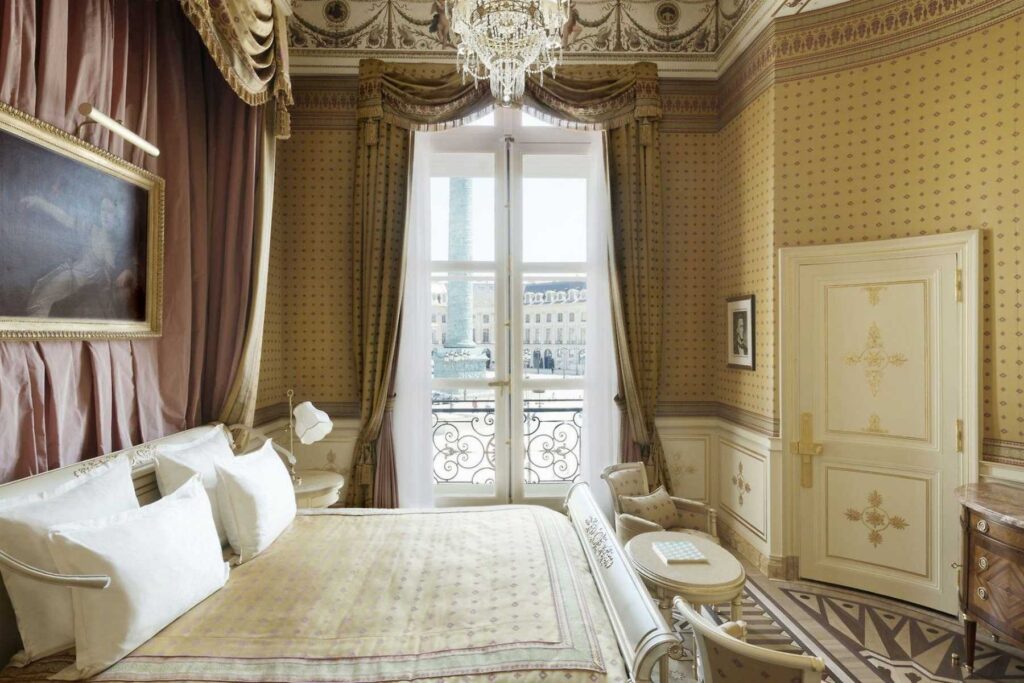The Ritz in Paris stands as a tribute to the timeless allure of luxury and innovation in hospitality. Established by César Ritz in 1898, this iconic establishment redefined what it meant to experience opulence, combining exquisite architecture with groundbreaking amenities.
Starting with the groundbreaking en-suite bathrooms to the culinary masterpieces crafted by the legendary Auguste Escoffier, the Ritz not only attracted the elite but also set unprecedented standards in the hotel industry. As we explore the stories of its glamorous guests and cultural impact, one must wonder how the Ritz maintained its prestigious allure through the ever-changing tides of history.
Founding of the Ritz

Founded by the visionary César Ritz, the Ritz Paris emerged as a paragon of luxury and innovation in the hospitality industry. Born in Switzerland, Ritz began his illustrious career humbly as a waiter, eventually working his way through Europe’s finest hotels. His Ritz vision was groundbreaking; he sought to create a haven where the elite could bask in unparalleled comfort.
In 1896, he established The Ritz Company Ltd in London before setting his sights on Paris, where he crafted a hotel that became the epitome of opulence. Ritz’s legacy as a hotelier is marked by his commitment to redefining luxury. His partnership with culinary maestro Auguste Escoffier added a delectable layer to the hotel’s allure, ensuring that fine dining was as much a part of the experience as the plush surroundings.
The opening of the Ritz Paris on June 1, 1898, was a grand affair, attended by luminaries like Marcel Proust. But it wasn’t just the famous faces that set the Ritz apart; it was the hotel’s groundbreaking features—private bathrooms, telephones, and elevators—that genuinely cemented its status. Ritz’s innovative spirit continues to inspire hoteliers globally. The hotel is located at 15 Place Vendôme, a prime location in Paris known for its opulence and sophistication.

Architectural Transformation
Amidst the grandeur of Place Vendôme, the architectural transformation of the Ritz Paris stands as a proof of the seamless blend of historical charm and modern innovation. Once upon a time, two elegant private mansions—the Hôtel de Crozat and the Hôtel de Gramont—formed the backbone of what would become this iconic hotel.
Designed in the classical style by Pierre Bullet and adorned with a façade by Jules-Hardouin Mansart, these structures whispered tales of Louis XIV’s reign. As the years passed, the Ritz Paris underwent a fascinating design evolution. Charles Mewès stepped in for its grand opening in 1898, weaving modern marvels into its historical fabric. Fast forward to the 1980s and beyond, and you’ll find architect Bernard Gaucherel invigorating the space with a swimming pool and spas, while the 2012-2016 renovation by Thierry W. Despont took historical preservation to heart with a $450 million makeover.
This transformative journey guaranteed that while the Ritz Paris welcomed the conveniences of modernity—like telephones and lifts—it preserved its gilded elegance, making it a luxurious haven where history and innovation dance in perfect harmony. The Ritz Paris was the first hotel to offer en-suite bathrooms in every room, setting a precedent for luxury accommodations worldwide.
Pioneering Hotel Innovations
How does a hotel become synonymous with luxury and innovation? The Ritz in Paris paved the way with pioneering guest amenities and technological features that set new standards in the hospitality industry. Envision stepping into a world where every room boasted its own bathroom and toilet—a groundbreaking concept at the time.
This was just the beginning of the Ritz’s quest for excellence. Picture elevators and telephones at your beck and call, eliminating the need for arduous stair climbs and tedious telegram waits. And let’s not forget the delightful touch of fresh bread service, a rarity in its day.
The Ritz didn’t stop at creature comforts. It welcomed technological advancements with enthusiasm, lighting up rooms with electricity—a luxury few had experienced before. Fast forward to the 21st century, where TVs hide cleverly behind mirrors, and touchpad controls adjust lighting and climate with a mere tap.
The hotel’s dedication to enhancing guest experiences is legendary. In its quest to maintain its status as a symbol of luxury, Ritz Paris continues to adapt and innovate, incorporating modern amenities while preserving its historical charm. Bathrooms expanded, room numbers reduced—an ingenious way to offer more space and personalized service. Even the peach-colored towels had a purpose: to flatter guests’ complexions. The Ritz in Paris effortlessly married opulence with innovation, ensuring every stay felt like a royal affair.
Escoffier’s Culinary Revolution
As the Ritz in Paris set new benchmarks for luxury and innovation in hospitality, it also became the stage for a culinary revolution led by the legendary Auguste Escoffier. His culinary techniques, a blend of tradition and modernity, simplified French cooking by codifying the five mother sauces, a cornerstone of Escoffier’s Culinary Legacy. Envision a kitchen bustling with precision and elegance, like a perfectly orchestrated symphony where each note matters. Escoffier’s creations, from *Peach Melba* to *filets de sole Coquelin*, tantalized taste buds and redefine dining luxury.
The *brigade de cuisine* system, another feather in Escoffier’s cap, brought military precision to the kitchen. With roles like Chef de Cuisine and Saucier, it guaranteed efficiency, discipline, and perhaps a little less kitchen chaos—though one wonders if the Rôtisseur ever traded jokes with the Poissonier over a simmering pot. His innovative planning and flair for menu design made dining at places like the Ritz not just a meal, but an event.
By introducing à la carte menus and stylish dining experiences, he transformed societal dining norms, elevating the chef’s status and the art of dining itself. Escoffier’s commitment to fresh, wholesome ingredients ensured that every dish not only delighted the palate but also upheld the highest standards of quality and taste.
Celebrities and Iconic Guests

The Ritz Paris stands as a symbol of elegance and exclusivity, attracting an illustrious array of celebrities and iconic guests throughout its storied history. From Coco Chanel‘s long-term residence to Ernest Hemingway‘s frequent visits, the hotel has been the backdrop for countless celebrity encounters and iconic moments.
Chanel, with her legendary style, called the Ritz home for over 30 years, adding a touch of haute couture to its grandeur. Hemingway, one of literature’s giants, found inspiration within its luxurious walls, leading to a bar being named in his honor—a fitting tribute to his lively spirit.
The Ritz’s guest list reads like a who’s who of historical figures. F. Scott Fitzgerald and Zelda frolicked in its opulent halls, while the tragic last dinner of Lady Diana and Dodi Al-Fayed remains etched in the annals of history. Artistic luminaries like Sarah Bernhardt and Audrey Hepburn also graced the Ritz, adding their creative flair.
The hotel’s allure even drew musicians like Elton John and Charlie Chaplin, turning every corner into a stage for unforgettable moments. The hotel was the first in Paris to feature modern conveniences such as elevators, electricity, telephones, and en-suite bathrooms, setting high standards that revolutionized the luxury hotel experience. With each celebrity visit, the Ritz Paris cemented its status as a timeless icon of luxury and sophistication.
Cultural Impact and Legacy

Renowned for its cultural significance, the Ritz Paris consistently exemplifies the pinnacle of architectural innovation and luxury standards. Situated behind the elegant façades of 18th-century townhouses designed by Pierre Bullet, the hotel revolutionized hospitality with its introduction of elevators, electricity, and en-suite bathrooms.
These innovations set a global benchmark for luxury hotels, making the Ritz a symbol of opulence and comfort. The Ritz Paris has always prioritized sustainable practices, being the first hotel in France to receive GSTC certification, which further enhances its legacy of excellence.
The Ritz Paris is a muse. Its literary influence is profound, with famed authors like Marcel Proust and F. Scott Fitzgerald finding inspiration within its lavish walls. Proust even wrote parts of his novels in his room, while Hemingway’s “The Sun Also Rises” immortalized its grandeur. The hotel is a cultural icon, appearing in plays like Noël Coward’s “Semi-Monde”, and enchanting audiences in films such as Billy Wilder’s “Love in the Afternoon”.
Its halls whisper tales of royalty and high society, hosting figures from the Duke and Duchess of Windsor to Coco Chanel. The Ritz stands as a historical narrative itself, a silent witness to pivotal events, maintaining an aura of timeless elegance that continues to captivate the world’s elite.
Renovation and Modernization

In 2012, a pivotal decision was made to renovate the Ritz Hotel Paris, driven by its inability to meet the criteria for the prestigious “Palace” status. This grand undertaking, spearheaded by Mohamed Al Fayed, aimed to elevate the guest experience while embracing historical preservation. For the first time in its storied history, the hotel closed its doors, determined to blend the charm of its 18th-century French decor with modern amenities. The Ritz’s outdated facilities cried for an upgrade, much like a smartphone yearning for its latest software update.
The renovation spanned four years and reached a staggering cost of $450 million, involving a talented ensemble of over 600 artisans, each a maestro in their craft. New electrical, plumbing, and air conditioning systems were discreetly introduced alongside playful touches like TVs hidden in mirrors. Yet, the hotel’s soul remained untouched; classical furniture and period antiques were lovingly restored, and the signature gold-and-blue palette was subtly refined. This monumental effort, one of the most expensive hotel renovations ever, underscored the Ritz’s luxurious reputation and its ability to seamlessly integrate history with modernity.
Moreover, the renovation reimagined the hotel’s layout by reducing rooms and introducing luxurious features like a glass-covered courtyard and the world’s first Chanel Spa, ensuring the Ritz remains an opulent sanctuary for years to come.
Current Luxury Offerings






Following its extensive renovation, the Ritz Paris now boasts an array of luxury offerings that seamlessly blend tradition with state-of-the-art amenities. Picture stepping into one of the 71 lavish rooms or suites, where modern technology is elegantly concealed behind gilt-framed mirrors. These current amenities guarantee a seamless experience, complete with complimentary Wi-Fi and Italian marble bathrooms that bask in natural light. For those who prefer a touch of history with their luxury experiences, the 16 Prestige Suites, named after luminaries like Hemingway and Chanel, offer a glimpse into the lives of the illustrious past guests.
Dining at the Ritz is nothing short of an adventure. The astrally-themed Ritz Bar and the legendary Bar Hemingway invite guests to indulge in signature cocktails crafted with aged spirits. Meanwhile, Bar Vendôme and Salon Proust provide cozy retreats with Parisian flair. If your taste buds demand the extraordinary, L’Espadon, led by Michelin-starred Chef Michel Roth, is a culinary journey not to be missed. As the most expensive hotel in Paris, the Ritz Paris embodies a level of opulence and exclusivity that is unmatched in the city.
With a dedicated staff of 600, the Ritz Paris guarantees that every need is met with elegance and precision. From exclusive activities to serene gardens, this independent hotel continues to enchant royalty and celebrities alike.
Wrapping up
The Ritz in Paris, an epitome of luxury, continues to captivate with its rich history and opulent offerings. Impressively, it was the first hotel to feature en-suite bathrooms, a groundbreaking innovation at the time. Its legacy is intertwined with illustrious guests and cultural milestones, making it a symbol of elegance and sophistication. As it evolves, the Ritz remains a proof of timeless luxury, where history and modernity blend seamlessly, ensuring its place as an iconic destination for generations to come.





